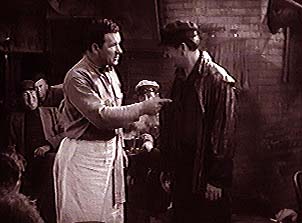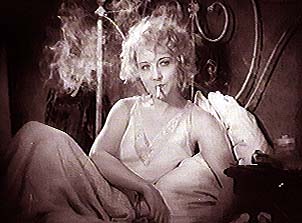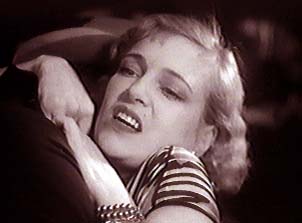

Oddly enough, the weakest part of "The
Docks of New York" (1928) is the story. Not that it's poor
story, but there are so many more from this period of the silent
era that have better stories. Yet, "The Docks of New York"
is a better "film"  than most of them.
than most of them.
That may sound strange, but not when one considers the credit that must go to director Josef von Sternberg for all the other aspects of this film that make it the cinematic achievement it is. Kevin Brownlow said it is "the greatest film von Sternberg ever made." (The Parade's Gone By, University of California Press, 1968). We can go a step further, though. It is among the best of the best from a period of time when film-making was at its zenith. It is a shining example of how far movie-making had come in three decades and the sheer aesthetic beauty that could be put on film.
First and foremost in contributing to the
greatness of this film are the characterizations a word
that doesn't do justice to what von Sternberg has given us because
the people (a better word than "characters" for this
film) are real, a true slice of life - albeit not so glamorous
- but true to this world, not some fantasy land that exists only
in a writer's imagination. Von Sternberg "achieves a feeling
of warmth and humanity he seems to care about his characters
instead of using them as in some of his sounds films to form patterns
of light and shade," Brownlow said. William K. Everson observed,
"'Docks of New York' represented something of a high point
in his (von Sternberg's) personal style and was also one of his
best pictures perhaps because for once it was about real
people, and because von Sternberg handled his actors (George Bancroft
and Betty Compson in particular) as intelligent individuals rather
than as puppets." (American Silent Film, Oxford University
Press, 1978).
All four of the primary actors/actresses in this film gave superb performances. How much credit should go to von Sternberg and how much should go to the actors/actresses themselves is debatable, but the end result is the same. George Bancroft as the muscular, assertive stoker Bill Roberts is intimidating, yet kind-hearted bullying, yet likeable rough, yet gentle. We begin to feel the spiritual connection from the outset with Betty Compson's character, Mae, a prostitute who tries to commit suicide but is rescued by Bill. It's not just gratitude when she warms up to him. There's a kindred spirit there, something about the two that clicks.
It goes without saying that the interaction between these two is the flame that makes this film burn brightly, yet it goes much further than that. We are drawn into these two lives, at once in sympathy with them and in admiration of them for their defiance of convention in grabbing what happiness they can in their dirty, seedy world. Certainly, we pity the frail Mae, puffing a cigarette arrogantly while recuperating in the stark, dingy room above the bar and telling Bill "You coulda saved yourself the trouble an' let me die." However, in spite of his cocky self-assurance, we pity Bill to some degree, too - his life as a stoker - hot, dirty, lonely spending a month or more at a time at sea obviously without any family looking for the next port and a few hours to have a good time. One character is weak and lacking self-esteem, the other strong and bursting with ego yet Bill and Mae elicit the same reaction from the viewer.
Olga Baclanova is excellent as Lou, the
prostitute who spends her life in a dingy bar on the docks clinging
to men who are necessary for her survival. Mitchell Lewis is pleasingly
disgusting as Andy, the third engineer from Bill's ship and Lou's
long-lost husband who had disappeared for three years.
At first we are led to believe Lou is tough and thick-skinned, especially at the sudden apparition of her husband. However, she wins our admiration and reveals her compassion when she readily comes to Mae's aid after she is brought in from the near-drowning. Later, when Bill and Mae are married, Lou pulls out her wedding ring and gives it to them with the comment, "I hope it does you more good than it did me!" This is our first indication that something was stirred in her when her husband appeared on the scene. This is more than confirmed in the end when she shoots Andy after he sneaks in Mae's room and attempts to rape her. This act is not so much to protect Mae as to avenge the wrong that has been done her as a wife, not only in the attentions to another woman, but for three years of desertion, as well.
Not enough can be said about the "look" and "feel" of this film, the cinematography - shadowy and moody - and the sets stark and ominous. Everson claimed, "Photographically, it is still one of the glories of the American cinema." James Card praised it even further. "The entire film, save for the ending, immerses the viewer in a poetic idealization of the kind of place the New York waterfront ought to be but certainly is not. The docks, fog-shrouded at night, and in daytime glistening in softened sunlight, are just what one might dream of finding where the big ships come into the great port of New York Harbor. The nights are moonwashed with mystery, and not even the daylight dispels von Sternberg's pictorial magic." (Seductive Cinema, Alfred A. Knopf, 1994). Brownlow summed it up when he said the film "looks like a massed collaboration of the finest European and American directors, art directors, and lighting cameramen."
The film is filled with impressive visuals.
One is Mae's attempted suicide. In the undulating water, we see
the inverted reflection of a female on the dock looking downward.
She bends at the knees, then jumps, disappearing offscreen to
the right. Water is splashed into the frame, and ripples upset
the water in our view a much more mysteriously moving scene
than if Mae's actions were viewed directly.
Another is the shooting of Andy. The last shot we see of Andy he is grabbing for Mae to force himself on her. The next shot is an outside view of the doorway of the room. Lou's back is to the camera as she moves slowly into the room and closes the door behind her. We next see a group of pigeons who have congregated on a ledge outside an open window in the room. Suddenly two puffs of smoke cross the screen as the pigeons flutter and scatter - clearly indicating gunshots have been fired. Not only is this much more effective in a visual sense, it also allows von Sternberg to keep us in suspense as to whether Mae or Lou fired the shots.
Everything comes together in this film to make it an utterly enjoyable viewing experience. Von Sternberg gives us the gritty realism, in an artistic way, of two very unglamorous lives on the waterfront without depressing us. No one has a sudden reverse in fortunes or becomes something totally different than he or she was a the beginning of the film, but we are left with hope for the two main characters. There is something positive out there in their futures. Von Sternberg deserves credit for not trying to take realism to the limit and shove it down our throats. Actually, von Sternberg told Brownlow in an interview in the 1960's, " . . . the illusion of reality is what I look for, not reality itself."
Fortunately, a superb print of "The Docks of New York" survives so the pictorial beauty is not lost to today's viewers. With a good music score (the Paramount video release has an excellent Gaylord Carter organ score) to complete the ingredients, "The Docks of New York" is without a doubt one of the high marks of silent cinema.